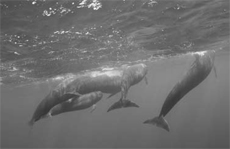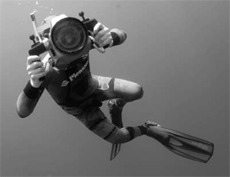




| Home | Features | Club Nights | Underwater Pics | Feedback | Non-Celebrity Diver | Events | 8 August 2025 |
| Blog | Archive | Medical FAQs | Competitions | Travel Offers | The Crew | Contact Us | MDC | LDC |

|

|
 
 |
 |
Whale WatchingSteve WarrenSnorkelling on the open ocean, you become very aware that there's nowhere to hide. There's no cover, no refuge. But if you are searching out that special encounter, the vastness of the sea provides the perfect hiding place for your quarry. And so, as I strain my eyes against the Atlantic haze, finger poised on 'Record', I really expect to see nothing at all. Then, ahead of me, Andrew (AJ) Pugsley, swiftly duck dives. Five metres down, he pauses. A nugget of blue water darkens, then takes on form. Even though I think I've planned for this moment, I'm taken by surprise the apparition that materialises on my monitor is bigger than a man and slender bodied. Its head is blocky, with pouting lips and inquisitive eyes. The baby pilot whale hangs level with AJ. For a few moments the breathholders consider each other with a mixture of intrigue and caution. Then, seemingly from nowhere a protective adult emerges and chaperones the fascinated and reluctant calf into the depths. |
 |

|
This is an exotic experience, but not an exotic destination. AJ
and I are just an hour out from the port of Gibraltar, free-diving
the clear waters of the Straits. Behind us, stands the fortress city,
the famous rock that bookends the tip of Europe. Northwards
the Spanish and Portuguese coastlines dip under the Atlantic
Ocean. And south the mountains of Morocco herald Africa,
the Dark Continent. Far out in international waters, we're more
than half a kilometre above the seafloor flatlining on Cri Cri's
echo sounder.
|
|

|
Gibraltar is an unsung location. Yet it is steeped in diving history.
Haldane studied Navy divers here in the run up to developing
the first dive tables. Lionel "Buster" Crabbe learned to dive
on the Rock during World War II, countering Italian saboteurs
laying mines from their human torpedoes. Ian Fleming, 007's
creator, served in intelligence here around the same time
and was inspired to pen "Thunderball". The diving is excellent,
offering a myriad marine life, drops offs and wrecks, all just a
few minutes from shore. But AJ and I wanted something new
and different this trip and so we sought out whales.
The first underwater encounter for both ourselves and the whales has been measured in seconds. Back on board the Draco cruiser, we look to skipper, Nick Balban, to locate another pod to dive with. Out of the ordinary experiences usually depend upon the knowledge, skills, experience and willing of local experts to become reality. Nick and I have been friends and diving partners for fifteen years. Born into Gibraltar's most celebrated fishing dynasty, Nick knows the Straits, her inhabitants and their habits intimately. To stack the odds of success in our favour we asked Nick to run the dive for us and worked around his availability. |
 |
|
Pilot whales are year-round residents in the Gibraltar Straits,
making them easy to find. But locating a whale at the surface
is not the same thing as observing and filming them underwater.
Pilot whales aren't really whales – they are actually among
the largest of the dolphin family. They can reach 8 metres in
length and exceed three metric tones in weight. Cruising at 3
kilometres per hour and able to exceed 15 in bursts, they can
easily avoid us. Viz is around 20 metres. A slight alteration in
course and the whales will be out of our range of vision and
slip past unseen.
Atop Cri Cri's flying bridge, Nick scans the Straits for the pilot whales sickle dorsal fins. On the stern, AJ and I refit our kit and wait for Nick's command to enter the water. Nick's tactic is to watch the whales, then place Cri Cri several hundred metres ahead of the school. The engines are turned off. As quietly as possible we then slip off the back. We look to Nick for hand signals that indicate the direction of the oncoming whales. We're so low in the water that the whales are virtually upon us before we can see them ourselves. The whales punch out of the blue and AJ and I each snatch a deep breath and dive to meet them. As I level off, I hit 'Record' and pan from AJ to the pod. Two groups of pilot whales link up before me. Eight, including the lighter-skinned calf, fill the frame. One whale has thrown a pectoral fin across another's back and the pair swim as one. It's a very human gesture and it's impossible not to anthropomorphise. As the whales breach for air, I stay with them, gasping only a half breath, which will have to last me for the next minute or so. AJ is shooting stills. Then the pilot whales dive vertically into the abyss. Pilot whales in the Gibraltar Straits feed on cuttlefish that live on the seafloor. Able to make depths of 500 metres, these highly intelligent mammals have been trained for military operations, including torpedo recovery. Equipped with echo location systems far more advanced than modern SONAR, pilot whales could be more effective for some tasks than divers or remote operated vehicles. They are among the most numerous of cetaceans. In European waters they are the target of a controversial hunt by the Faroese. Driven into shallow bays, the whales are gaffed through their blow holes to secure them. Arteries in their necks are then slashed open with knives to kill the creatures. Though sustainable, the killing in family groups of these sociable animals by such methods attracts strong criticism. The Faroese justify the slaughter on economic and cultural grounds. Off Gib, the pilot whales are not hunted. But to survive they must avoid the thousands of vessels that ply this trade route annually and put up with a pack of whale watching boats. Harassment isn't only from humans. Dolphins are known to bully the pilot whale calves as well. Their patience with divers can be strained. Though pilot whales may choose to interact with us, they've also been known to kick back. Off Hawaii, Lisa Costello was taken by the leg by a pilot whale and dragged down to 12 metres. As Lee Tepley, her famed film-making partner rolled his camera, the whale suddenly thought better of its decision and returned Lisa to the surface, where it released her. As the pilot whales pass by once again and with my own camera rolling, a large animal splits away from the group and closes with us. Bubbles stream from its blow hole and staccato clicks fill the water like rapid small arms fire. The whale barrel rolls beautifully and then delivers two sharp swipes at AJ and myself with its flukes. Contact with that flying tail fin would have left both of us as damaged goods. But the pilot whale deliberately missed us – it was just a warning shot across the bows. We've outstayed our welcome. The whales sound silently once more into the depths. It's late afternoon and shafts of light lance the water in their wake. I lie back on the open sea and await Cri Cri. |
 | |
|
If you'd like to freedive with pilot whales, contact Steve at Ocean Optics – Mavericks Diving. Also, look out for their other events and training opportunities coming up this summer, including the Marine Biology Course on 7th June with expedition leader and writer Jamie Watts. mavericksdiving.co.uk Nearest recompression chamber UMH Jacrissa, Clínica el Ángel, Málaga Tel: 952 330 223 |
 | |
Previous article « Being a Girl Tekkie Next article » Deep Caves of Ras Mohammed Back to Issue 4 Index | ||